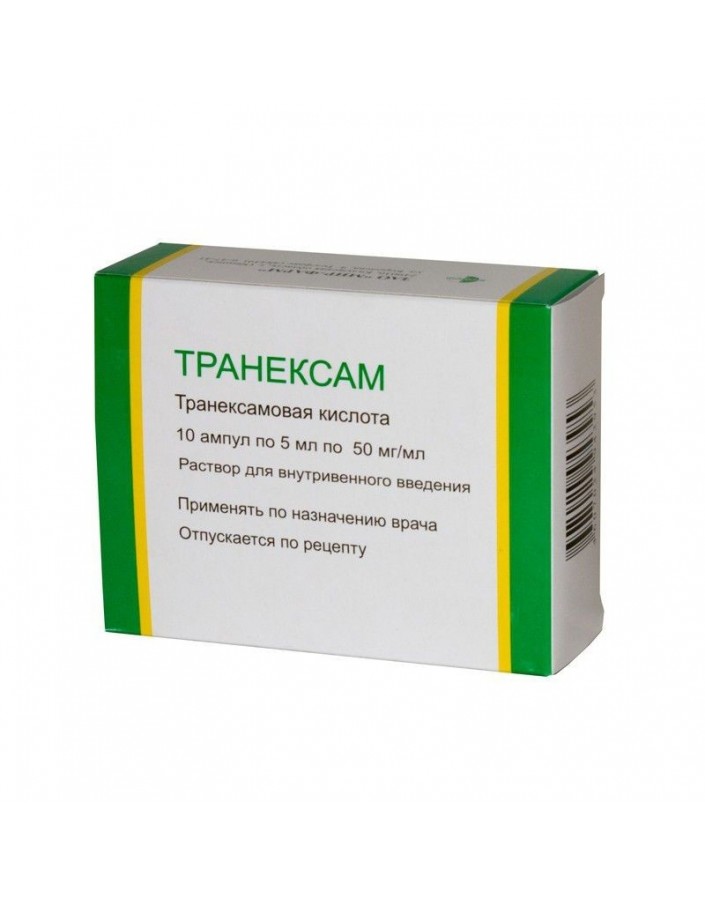




Security policy (edit with Customer reassurance module)

Delivery policy (edit with Customer reassurance module)

Return policy (edit with Customer reassurance module)
In blisters of 5 ampoules (with 5 ml of solution).
Hemostatic, anti-inflammatory, anti-allergic.
Tranexamic acid is an antifibrinolytic agent that specifically inhibits the activation of profibrinolysin (plasminogen) and its conversion to fibrinolysin (plasmin). It has a local and systemic hemostatic effect in bleeding associated with increased fibrinolysis (platelet pathology, menorrhagia), as well as anti-inflammatory, antiallergic, anti-infective and anti-tumor effects due to the suppression of the formation of kinins and other active peptides involved in allergic and inflammatory reactions. The experiment confirmed its own analgesic activity of tranexamic acid, as well as the over-total potentiating effect on the analgesic activity of opiates.
Bleeding or risk of bleeding against the strengthening of fibrinolysis as generalized (bleeding during surgery and in the postoperative period, post-partum bleeding, manual removal of the placenta, placental chorionic, bleeding during pregnancy, cancer of the pancreas and prostate, hemophilia, hemorrhagic complications of fibrinolytic therapy, thrombocytopenia purpura, leukemia, liver disease, previous therapy with streptokinase), and local (uterine, nasal, pulmonary, stomach intra-intestinal hemorrhages, hematuria, hemorrhages after prostatectomy, cervix conization for carcinoma, tooth extraction in patients with hemorrhagic diathesis). Operative interventions on the bladder, surgical procedures for systemic inflammatory reaction (sepsis, peritonitis, pancreatic necrosis, severe and moderate severity of gestosis, shock of various etiologies and other critical conditions).
Hypersensitivity to the drug, subarachnoid hemorrhage. Precautions: thrombosis (cerebral thrombosis, myocardial infarction, thrombophlebitis) or the threat of their development, thrombohemorrhagic complications (in combination with Heparin and indirect anticoagulants), impaired color vision, hematuria from the upper urinary tract (ian).
With generalized fibrinolysis A single dose of 15 mg / kg is administered every 6–8 hours, the rate of administration is 1 ml / min.
With local fibrinolysis The administration of the drug in a dose of 250–500 mg 2-3 times a day is recommended.
For prostatectomy or bladder surgery during the operation, 1 g is administered, then 1 g every 8 hours for 3 days, after which they are transferred to the ingestion of a pill form until the gross hematuria disappears.
With a high risk of bleeding, with a systemic inflammatory responseand - at a dose of 10–11 mg / kg 20–30 minutes before the intervention.
Patients with coagulopathy before tooth extraction administered at a dose of 10 mg / kg, after extraction of the tooth prescribed oral pill form of the drug.
In case of violation of renal excretory function correction of the dosage regimen is necessary depending on the concentration of creatinine in the blood: when the creatinine concentration in the blood is 120–250 mcmol / l, 10 mg / kg is prescribed 2 times a day; at 250–500 μmol / l - 10 mg / kg once a day; when> 500 mcmol / kg - 5 mg / kg 1 time per day.
Nausea, vomiting, heartburn, diarrhea, rash, itching, loss of appetite, drowsiness, dizziness. There may be a violation of color vision, rarely - thrombosis, thromboembolism, urticaria, weakness, drowsiness, tachycardia, chest pain, hypotension (with a rapid on / in the introduction), blurred vision.
Before and during treatment, an oculist examination is necessary (determination of visual acuity, color vision, and fundus condition).
At temperatures not above 25 ° C. List B.
Tranexam